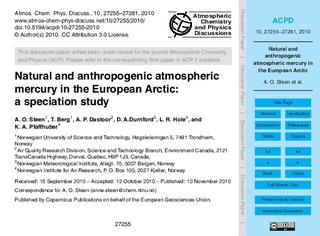| dc.contributor.author | Steen, Anne Orderdalen | |
| dc.contributor.author | Berg, Torunn | |
| dc.contributor.author | Dastoor, Ashu P. | |
| dc.contributor.author | Durnford, Dorothy, A. | |
| dc.contributor.author | Hole, Lars Robert | |
| dc.contributor.author | Pfaffhuber, Katrine Aspmo | |
| dc.date.accessioned | 2015-11-11T12:34:01Z | |
| dc.date.accessioned | 2015-11-11T15:29:27Z | |
| dc.date.available | 2015-11-11T12:34:01Z | |
| dc.date.available | 2015-11-11T15:29:27Z | |
| dc.date.issued | 2010 | |
| dc.identifier.citation | Atmospheric Chemistry and Physics Discussions 2010, 10(11):27255-27281 | nb_NO |
| dc.identifier.issn | 1680-7375 | |
| dc.identifier.uri | http://hdl.handle.net/11250/2360140 | |
| dc.description.abstract | It is agreed that gaseous elemental mercury (GEM) is converted to reactive gaseous mercury (RGM) during springtime Atmospheric Mercury Depletion Event (AMDE). RGM is associated with aerosols (PHg) provided that there are sufficient aerosols available for the conversion from RGM to PHg to occur.
This study reports the longest time series of GEM, RGM and PHg concentrations from a European Arctic site. From 27 April 2007 until 31 December 2008 composite GEM, RGM and PHg measurements were conducted in Ny-Ålesund (78°54' N, 11°53' E). The average concentrations of the complete dataset were 1.62±0.3 ng m−3, 8±13 pgm−3 and 8±25 pgm−3 for GEM, RGM and PHg, respectively. The study revealed a clear seasonal distribution of GEM, RGM and PHg previously undiscovered. For the complete dataset the atmospheric mercury distribution was 99% GEM, whereas RGM and PHg constituted <1%. Increased PHg concentration occurred exclusively from March through April, and constituted on average 75% of the reactive mercury species in the respective period. RGM was suggested as the precursor for the PHg existence, but long range transportation of PHg has to be taken into consideration. Surprisingly, RGM was not solely formed during the spring AMDE season. Environment Canada's Global/Regional Atmospheric Heavy Metal model (GRAHM) suggested that in situ oxidation of GEM by ozone may be producing the increased RGM concentrations from March through August. Most likely, in situ oxidation of GEM by BrO produced the observed RGM from March through August. The AMDEs occurred from late March until mid June and were thought to be of non-local origin, with GEM being transported to the study site by a wide variety of air masses. With some exceptions, no clear meteorological regime was associated with the GEM, RGM and PHg concentrations. | nb_NO |
| dc.language.iso | eng | nb_NO |
| dc.publisher | European Geosciences Union | nb_NO |
| dc.title | Natural and anthropogenic atmospheric mercury in the European Arctic: a speciation study | nb_NO |
| dc.type | Journal article | nb_NO |
| dc.type | Peer reviewed | en_GB |
| dc.date.updated | 2015-11-11T12:34:01Z | |
| dc.source.pagenumber | 27255-27281 | nb_NO |
| dc.source.volume | 10 | nb_NO |
| dc.source.journal | Atmospheric Chemistry and Physics Discussions | nb_NO |
| dc.source.issue | 11 | nb_NO |
| dc.identifier.doi | 10.5194/acpd-10-27255-2010 | |
| dc.identifier.cristin | 518584 | |
| dc.description.localcode | © Author(s) 2010. This work is distributed under the Creative Commons Attribution 3.0 License. | nb_NO |
